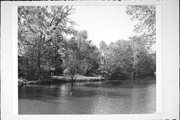Property Record
ROCK RIVER, TIVOLI ISLAND
Architecture and History Inventory
| Historic Name: | Concordia Island |
|---|---|
| Other Name: | Tivoli Park |
| Contributing: | |
| Reference Number: | 79508 |
| Location (Address): | ROCK RIVER, TIVOLI ISLAND |
|---|---|
| County: | Jefferson |
| City: | Watertown |
| Township/Village: | |
| Unincorporated Community: | |
| Town: | |
| Range: | |
| Direction: | |
| Section: | |
| Quarter Section: | |
| Quarter/Quarter Section: |
| Year Built: | 1874 |
|---|---|
| Additions: | |
| Survey Date: | 1986 |
| Historic Use: | park |
| Architectural Style: | NA (unknown or not a building) |
| Structural System: | |
| Wall Material: | |
| Architect: | |
| Other Buildings On Site: | |
| Demolished?: | No |
| Demolished Date: |
| National/State Register Listing Name: | Not listed |
|---|---|
| National Register Listing Date: | |
| State Register Listing Date: |
| Additional Information: | A 'site file' exists for this property. It contains additional information such as correspondence, newspaper clippings, or historical information. It is a public record and may be viewed in person at the Wisconsin Historical Society, State Historic Preservation Office. Located on an island historically between Smith's Bridge and Rough and Ready Bridge, presently known as the East Main Street Bridge and the Oconomowoc Avenue Bridge, Tivoli Island is comprised of four acres of land reached only water or by the Tivoli Island Bridge. Two thousand shaded trees were planted on the island by the Concordia Society who purchased the island in 1874. Although improvements such as a fountain, pavilion and bowling alley were constructed on the island by the Concordia Society, none are extant. Presently exhibiting only a naturalized environment, the former Concordia Island site does not meet the requirements for architectural significance. However, Concordia Island now known as Tivoli Island meets the requirements for historical significance. This nature park was originally developed as a private recreation park by the Concordia Music Society, then fell into the hands of private owners, then finally became a city park. The Concordia Music Society was one of the most popular social and entertainment groups in the late nineteenth century. They operated a music hall until the 1910s and in 1874 took over this island in the Rock River for recreational purposes. They called it Concordia Island, and in the 1880s and 1890s, it was a popular spot for local residents. It had a pavilion for music and dancing activities and bowling alleys, and picnicing there was a popular activity for Watertown citizens in the summer time. Some time in the early twentieth century the Concordia Society sold the island to private owners who operated it as a resort attraction, and eventually it became part of the city park system. The pavilion and other structures have all been demolished and currently the parks department manages the island as a nature park. Tivoli Park is significant for local history under National Register criterion A because it is associated with the Concordia Music Society group, an important entertainment and recreational society of the nineteenth and early twentieth century. The development of the Concordia Music Society grew out of the German settlement in Watertown. Many of tghe German immigrants brought with them a love of music, and some were highly educated middle and upper class persons used to patronizing the arts in their homeland. Germans, in general, were also known for their socializing. It is significant that the music society would branch out into the acquisition of and island for recreational purposes. Many sources indicate that Concordia Island was a popular recreation spot during the turn of the century years, and in an era before the estbalishment of city parks, Concordia Island filled a recreational need not being met by the community as a whole. Probably frequented by the middle classes, Concordia Island was still probably the closest thing to a community park the city had in the ninteenth century. For these reasons Tivoli Park is significant for local history. It is interesting that the city eventually acquired the island already established, the island is now a nture preserved, protecting some of the natural environment of the Rock River. |
|---|---|
| Bibliographic References: | (A) City of Watertown Park, Open Space and Outdoor Recreation Plan, Watertown: City of Watertown, 1985 (?), chapter 2, p. 1. (B) "German Settlers Brought Love of Music With Them When They Settled in Area," Watertown Daily Times Centennial Issue, June 26, 1954. (C) The History of Jefferson County, Wisconsin, Chicago: Western Historical CO., 1879, p,. 441. |
| Wisconsin Architecture and History Inventory, State Historic Preservation Office, Wisconsin Historical Society, Madison, Wisconsin |

